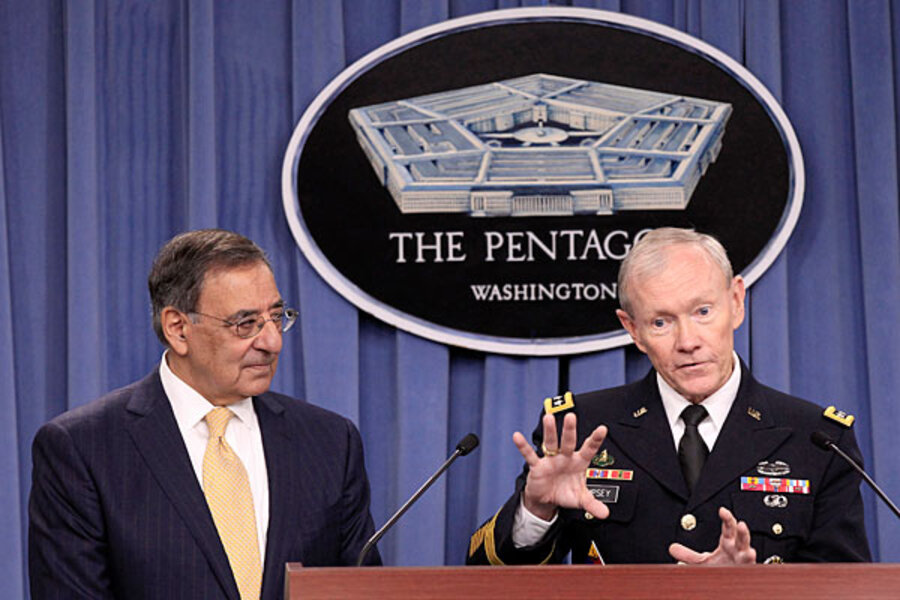Under new defense strategy, what is biggest threat facing US now?
| Washington
So just what kind of wars will the United States be fighting in the years to come? And whom does the Pentagon now see as the greatest threats to America?
In rolling out its new strategy review Thursday, Pentagon officials cited a new array of threats.
In the place of the post-9/11 war on terrorism, the Pentagon is turning its attention more toward a potentially aggressive China and rogue nuclear nations. And as much as any geographical location, the Pentagon is focusing on what it sees as the next great battleground: cyberspace.
Even with the war in Iraq barely over and the war in Afghanistan winding down, the new strategy implies that the two wars are already akin to Cold War-era relics – too expensive and manpower-intensive in an era of fiscal constraint.
The result is a dramatically changed worldview for the Pentagon – one that largely repudiates the wars it has been fighting for the past decade.
At the briefing Thursday, the nation’s top military officer made it clear that the fronts for potential conflicts are shifting dramatically toward China.
“All of the trends – demographic trends, geopolitical trends, economic trends, and military trends – are shifting towards the Pacific,” Chairman of the Joint Chiefs of Staff Martin Dempsey said. “So our strategic challenges in the future will largely emanate from out of the Pacific region.”
It was a recurring theme. “China’s emergence as a regional power will have the potential to affect the US economy and our security in a variety of ways,” the strategic review noted.
Yet it also came with a warning. “The growth of China’s military power must be accompanied by greater clarity of its strategic intensions in order to avoid causing friction in the region.”
On the subject of North Korea, there was little disagreement or nuance. The country is “actively pursuing a nuclear weapons program,” the strategy bluntly noted.
Iran received similar treatment, and at one point, the review lumps both China and Iran together. “States such as China and Iran will continue to pursue asymmetric means to counter our power projection capabilities.”
Echoing the review, Dempsey issued a warning for Iran, which is considering shutting down the vital Strait of Hormuz in response to international sanctions. “The message we’ve had consistently for Iran is that we expect them to be a responsible member of the community of nations, not deny freedom of navigation, freedom of movement, freedom of access,” said Dempsey, “and we are determined that they will not acquire a nuclear weapon.”
The new strategy made it clear that some of the greatest enemies America faces will be stateless extremists and hackers intent on waging cyberwarfare. “Modern armed forces cannot conduct high-tempo, effective operations without reliable information and communication networks and assured access to cyberspace and space,” it notes.
In broader terms, the strategy focused not just on the enemies that America faces, but also how it plans to fight its wars. One highly controversial aspect of the review was a movement away from the tenet that the US military should be able to fight two large conventional wars simultaneously.
Dempsey defended the move. “The two-war paradigm has been a bit of an anchor, frankly, in trying to help us figure out the future,” he said, calling it “a residual of the Cold War.”
Added Defense Secretary Leon Panetta, “How we defeat the enemy may vary across conflicts. But make no mistake, we will have the capability to confront and defeat more than one adversary at a time.”
Yet the strategy made it clear that the troop-heavy counterinsurgency campaigns in Iraq and Afghanistan are not the model for future warfare. “The Army and Marine Corps will no longer need to be sized to support the large-scale, long-term stability operations that dominated military priorities and force generation over the past decade,” Secretary Panetta said. “The US joint force will be smaller and leaner.”
Yet when asked about the threat of “opportunistic aggressors” like Iran who see that America is engaged in a ground war in Afghanistan through 2014 and decide to try press an advantage, Dempsey wouldn’t rule out waging such wars in the future.
“Nobody has said and nowhere in this document does it say we’re not going to fight land wars, it doesn’t say we’re never going to do stability operations,” he said. “It’s not about whether we will fight adversaries as they confront us – it’s how.”





